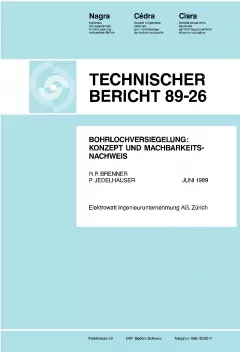
Technischer Bericht NTB 89-26
BohrlochversiegelungKonzept und Machbarkeitsnachweis
In this report criteria for sealing boreholes are first considered and the requirements for sealing materials are then specified. For the conceptual design of the seal use is made of a multiple-zone borehole plug consisting of key zones and intermediate zones in between. The key zones are located in competent, low-fissured rock and act as efficient barriers to prevent a drain effect by the borehole. Highly compacted bentonite in the form of cylinders with a diameter slightly smaller than that of the borehole and also in the form of spheres or pellets is used as plug material in the key zones, while cement is employed for the intermediate zones.
A review of the relevant literature has revealed that in past experiments mostly cement and bentonite were used as plug materials. The corresponding results showed that both materials are potentially successful candidates.
For plug emplacement, it is proposed to employ either a specially designed emplacement tool or a perforated pipe. The latter method is somewhat easier to use but the pipe has to remain in the borehole, i.e. in the key zone. It is recommended to have a dry density of the bentonite after swelling of not less than 1.3 Mg/m3. This implies limiting values for the space between the bentonite cylinder and the borehole wall. By means of a bentonite slurry filled into the borehole at the key zone, the allowable ring space can be slightly enlarged. For the use of bentonite in the form of spheres or pellets experimental data are scarce and emplacement procedures are not sufficiently developed to guarantee the required minimum final dry density.
In order to check the quality of the plug, an indirect procedure is recommended in which it is shown, by means of suitable tests, that with a certain emplacement method the plug is able to achieve the required sealing effect. For sealing boreholes penetrating into the repository zone, direct quality control is then limited to checking whether the procedure is adhered to as specified and to recording the quantities of materials emplaced.
Finally, it is shown that the proposed plug design represents an efficient flow barrier in spite of the increased permeability in the disturbed zone surrounding the borehole, and that it can satisfy the specified requirements.
